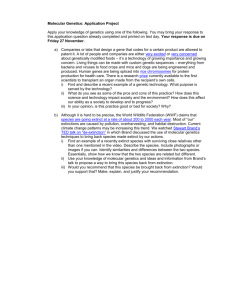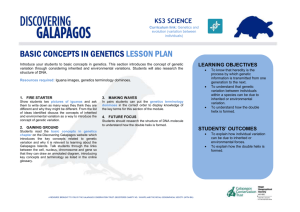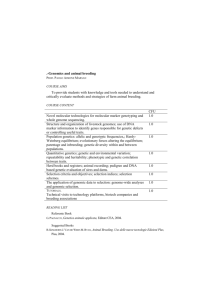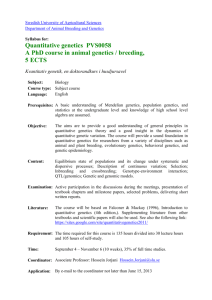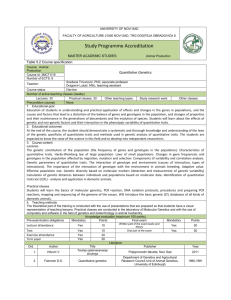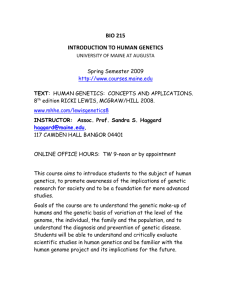anne seitz - Department of Ecology, Evolution, and Organismal
advertisement
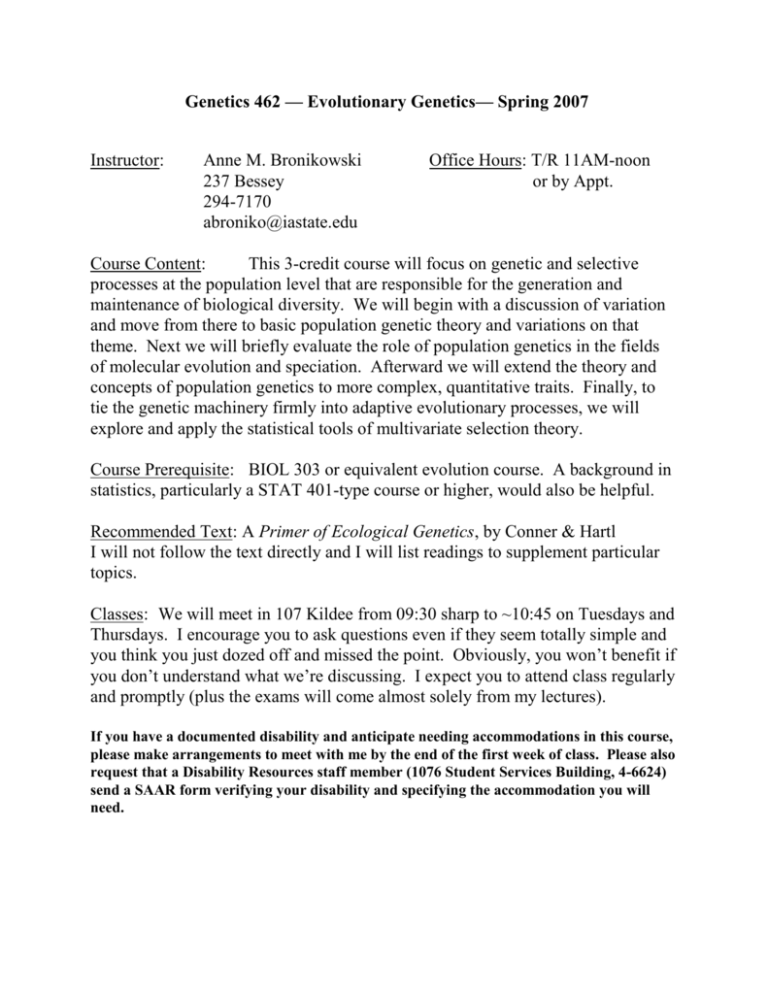
Genetics 462 — Evolutionary Genetics— Spring 2007 Instructor: Anne M. Bronikowski 237 Bessey 294-7170 abroniko@iastate.edu Office Hours: T/R 11AM-noon or by Appt. Course Content: This 3-credit course will focus on genetic and selective processes at the population level that are responsible for the generation and maintenance of biological diversity. We will begin with a discussion of variation and move from there to basic population genetic theory and variations on that theme. Next we will briefly evaluate the role of population genetics in the fields of molecular evolution and speciation. Afterward we will extend the theory and concepts of population genetics to more complex, quantitative traits. Finally, to tie the genetic machinery firmly into adaptive evolutionary processes, we will explore and apply the statistical tools of multivariate selection theory. Course Prerequisite: BIOL 303 or equivalent evolution course. A background in statistics, particularly a STAT 401-type course or higher, would also be helpful. Recommended Text: A Primer of Ecological Genetics, by Conner & Hartl I will not follow the text directly and I will list readings to supplement particular topics. Classes: We will meet in 107 Kildee from 09:30 sharp to ~10:45 on Tuesdays and Thursdays. I encourage you to ask questions even if they seem totally simple and you think you just dozed off and missed the point. Obviously, you won’t benefit if you don’t understand what we’re discussing. I expect you to attend class regularly and promptly (plus the exams will come almost solely from my lectures). If you have a documented disability and anticipate needing accommodations in this course, please make arrangements to meet with me by the end of the first week of class. Please also request that a Disability Resources staff member (1076 Student Services Building, 4-6624) send a SAAR form verifying your disability and specifying the accommodation you will need. Course Requirements: 1) In-class quizzes and assignments 20% Each quiz will consist of a single question just like I would ask on an exam (short essay and problem solving). You will have 10 minutes to finish (09:30-09:40), so come prepared and don’t be late! An unexcused absence will earn a grade of zero. I will implement occasional group problem sets that will improve your skills as well. 2) 3) Class presentation (as discussant) Class participation in discussions 10% 10% Each student will present a summary of a seminal paper in the field of evolutionary genetics that I will assign. These summary discussions will each have three assigned presenters. Everyone is required to participate in the discussion of each figure. When being graded as a discussant, the grade will be based on your preparation and presentation. When being graded as a participant, your grade will depend on whether you actively participate in the class discussion following the presentation, and whether you have prepared by reading the assigned paper. Obviously, failure to participate in a discussion shall equal a 0 for that date. 4) Midterm exam 30% The midterm exam will consist of about 10 questions. Coherent writing will be necessary to answer the questions; a calculator may be useful for some questions. Oh, and don’t cheat. I take it very seriously and do not tolerate it any form, not that I expect it to be a problem. As with the quizzes, an unexcused absence will earn a grade of zero. If you know you will miss the exam, tell me beforehand so we can make arrangements. The exam will cover classical population genetics, speciation genetics, and molecular evolution. 5) Final exam (take-home!) 30% It will focus entirely on problem solving and interpretation, will be comprehensive but emphasize the latter portion of the course (i.e., quantitative genetics and multivariate selection), and will be take-home. And, in case you forgot, don’t cheat. You can use other resources if you feel they are necessary, but you must work on the exam questions by yourself. I intend to hand out the exam in class on 26 April. It will be due in my office by 5 PM on 2 May so that we will have time to grade it. Genetics 462/562 — Evolutionary Genetics — Course Syllabus — Spring 2007 DATE TOPIC READING Conner & Hartl or [Crow & Dove] 1/9 Phenotypic diversity, genetic variation, Hardy-Weinberg principle pp. 1–36 1/11 Sex-linkage and linkage disequilibrium pp. 157–160 1/16 Non-random mating--Assortation and inbreeding pp. 36–43 1/18 Discussion 1 Godfrey Harold Hardy & Wilhelm Weinberg Hardy. 1908. Science 28: 49-50 Stern 1943. Science 97: 137-138 [54-57] 1/23 Random genetic drift--Effective population size, F-statistics pp. 52–66 1/25 Migration--Wahlund’s principle, Wright’s island model Stepping-stone model, private alleles pp. 47–51 1/30 Mutation 2/1 Discussion 2 Herman Joseph Muller 1927. Artificial transmutation of the gene. Science 66:84-87 [51-53, 238241, 632-637] 2/6 Natural selection--Fitness, selection coefficient Natural selection--overdominance, underdominance, etc. pp. 66–71 pp. 71–76 2/8 Discussion 3 Barbara McClintock 1951. Cold Spring Harbor Symp. Quant. Biol. 16: 13-47 [469-474, 516519, 688-692] 2/13 Still more natural selection--Mutation-selection balance, genetic load, pp. 76–89 Haldane’s Sieve, Fisher’s Fundamental Theorem 2/15 Speciation--isolating mechanisms, modes, reinforcement, Haldane’s Rule 2/20 Discussion 4 Theodosius Dobzhansky [31-34, 5551937. Genetic nature of species differences. Am Nat 71: 404-420 559,612-616] Speciation--isolating mechanisms, modes, reinforcement, Haldane’s Rule 2/22 Discussion 5 John Burdon Sanderson Haldane 1922. Sex-ratio and unisexual sterility in hybrid animals. J. Genet. 12: 101-109. [253-258, 617-631] 2/28 Neutral theory of molecular evolution, molecular clocks, selfish DNA 3/1 Discussion 6 Motôo Kimura 1968. Evolutionary rate at the molecular level. Nature 217: 624-626 [17-18, 93-96] 3/6 MIDTERM EXAM 3/8 Quantitative genetic traits & statistical measures/methods--phenotypic pp. 97–107, plasticity, reaction norms, genotype-by-environment interactions 137–145 3/20 Partitioning phenotypic variation; Repeatability 3/22 Discussion 7 Francis Galton [357-360,465-468] 1888. Co-relations and their measurement. Proc. R. Soc. London 45: 135 – 145. 3/27 Heritability--broad-sense, narrow-sense, estimation, interpretation pp. 112–133 3/29 Genetic covariances and correlations pp. 150–163 4/3 # of loci affecting a trait, QTL analysis pp. 170–180 4/5 Discussion 8 Richard C. Lewontin [227-232, 378-383] 1966. A molecular approach to the study of genetic heterozygosity in natural populations. Genetics 54:595-609 4/10 Experimental methods of quantitative genetics (QG w/o tears)-common gardens, wide crosses pp. 145–147 4/12 More quantitative genetics without tears--transplant experiments Selection differentials, response to selection pp. 147–149, 163–170 4/17 Multivariate selection--correlated response, selection gradient, predicting/reconstructing adaptive evolution pp. 189–210, 216–223 pp. 108–111 4/19 Discussion 9 Lynn Margulis 4/24 Adaptive landscapes and evolutionary equilibria 4/26 Visualizing multivariate selection RECEIVE FINAL EXAM 5/2 FINAL EXAM DUE BY 5 PM! pp. 210–211
